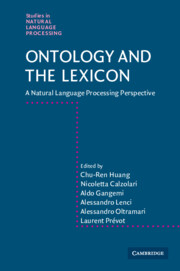Book contents
- Frontmatter
- Contents
- Contributors
- Preface
- Part I Fundamental aspects
- Part II Discovery and representation of conceptual systems
- Part III Interfacing ontologies and lexical resources
- Part IV Learning and using ontological knowledge
- 14 The life cycle of knowledge
- 15 The Omega ontology
- 16 Automatic acquisition of lexico-semantic knowledge for question answering
- 17 Agricultural ontology construction and maintenance in Thai
- References
- Index
17 - Agricultural ontology construction and maintenance in Thai
from Part IV - Learning and using ontological knowledge
Published online by Cambridge University Press: 06 July 2010
- Frontmatter
- Contents
- Contributors
- Preface
- Part I Fundamental aspects
- Part II Discovery and representation of conceptual systems
- Part III Interfacing ontologies and lexical resources
- Part IV Learning and using ontological knowledge
- 14 The life cycle of knowledge
- 15 The Omega ontology
- 16 Automatic acquisition of lexico-semantic knowledge for question answering
- 17 Agricultural ontology construction and maintenance in Thai
- References
- Index
Summary
Introduction
In this chapter, our ontology is meant to structure the knowledge we possess within the domain of agriculture. We encode real-world, taxonomical and non-taxonomical, task-oriented aspects (see Figure 17.1). Typical taxonomical relations are the hyponym-hypernym relations; non-taxonomical relations; synonyms, meronyms, or roles (i.e., functional relations), of which made-of, located-in, purpose-of, consist-of are a few examples; and task-oriented relations, both specific non-taxonomical and specific-action relations.
While the manual building of an ontology by an expert is time-consuming and expensive, maintaining it throughout its life cycle is an endless task, since new terms are created, and others become obsolete. In the domain of agriculture, certain terms grow very quickly, for example, plant species, disease names, etc., while others tend to disappear. Those that disappear have lived out their time, or they have simply been made obsolete by the appearance of new technology, for example: in 2002 pineapple was an example of an economic plant, while in 2008, oil palm had become an economic plant instead (see Figure 17.2).
In order to reduce the costs and to support this open-ended task, research on (semi-) automatic ontology building has been conducted using a variety of resources, such as raw text (Hearst, 1992; Maedche and Staab, 2001; Kietz et al., 2000; Yamaguchi, 1999; Navigli and Velardi, 2003; Li et al., 2005; Pustejovsky et al., 2002), dictionaries (Jannink, 1999; Kietz et al., 2000; Aramaki et al., 2005) and thesauri (Soergel et al., 2004; Clark et al., 2000; Wielinga et al., 2001; Kawtrakul et al., 2005).
- Type
- Chapter
- Information
- Ontology and the LexiconA Natural Language Processing Perspective, pp. 288 - 308Publisher: Cambridge University PressPrint publication year: 2010



